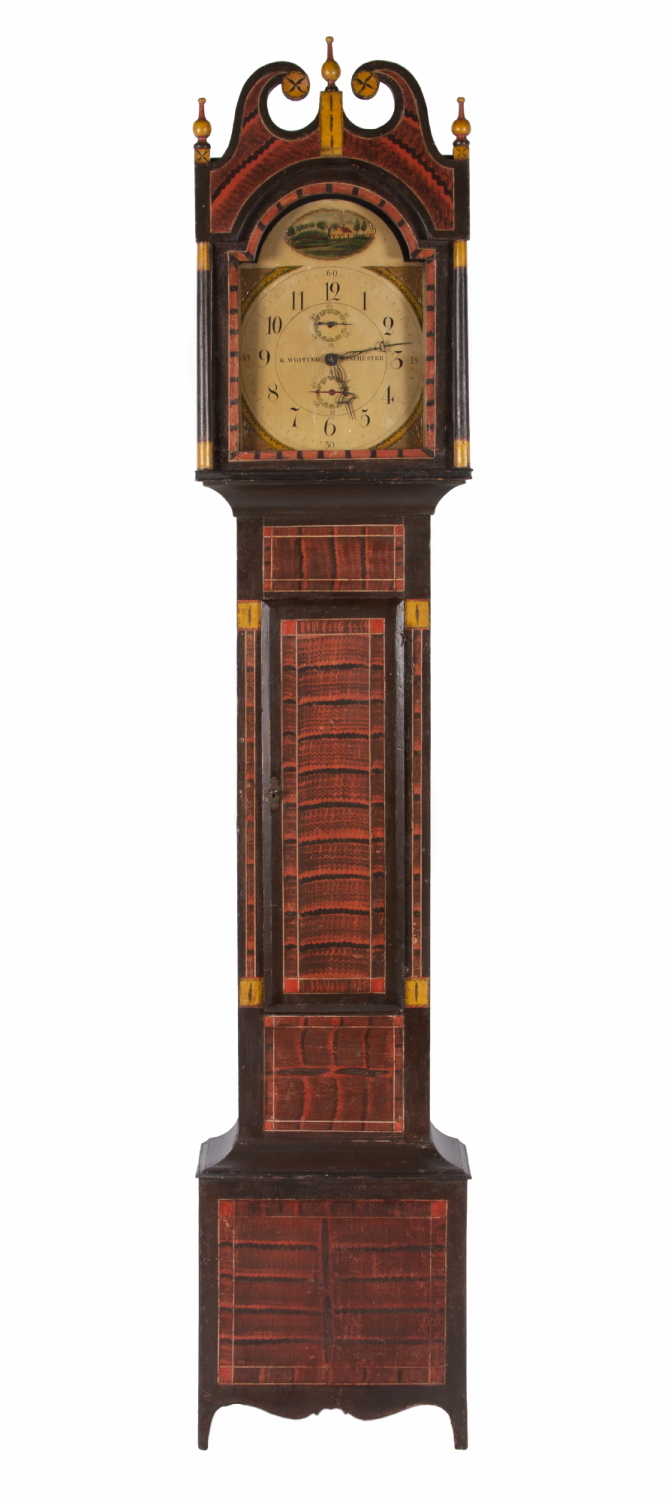
| |
EXHUBERANTLY PAINTED, NEW ENGLAND TALL CASE CLOCK IN DARK UMBER, RED, & CHROME YELLOW DECORATION, WITH WOODEN WORKS BY RILEY WHITING, PLYMOUTH, CONNECTICUT, CA 1819-1835 |
| |
|
| Dimensions (inches): |
89.5" t x 17.25" w x 9.75" d4 in. |
| Description: |
|
This wonderful tall case clock is one of a known and very special group of New England examples. Most of those identified, and this one in particular, have wooden works by Riley Whiting of Connecticut. The exuberantly paint-decorated cases have been attributed by some to Vermont and, in at least one case, more specifically, to the Matteson family of cabinetmakers who worked within that state.
The form is traditional for an American clock of the early 19th century, with a broken arch pediment, columns on either side of a tombstone-shaped face, concave moldings stepping down to a narrower case and then back out to the base, where there is a scalloped skirt, scrolling out to fine Hepplewhite feet.
The base color is dark umber, upon which are fanciful, rectangular, grain-painted designs, in strong, orangish-red and brown, made to look like inset panels. These are included on all three visible sides of the base and hood, as well as on the long, central case and door. The crown is likewise decorated, as-is the perimeter of the glass. The crown, columns, and the stiles that flank each side of the door, are punctuated with chrome yellow bands, squares, rosettes, and the like, and the finials are decorated in yellow and red. This particular design, with doors on both sides of the hood, is especially unusual among painted clocks.
The face features an oval landscape with a house and trees. Smoke rolls out the chimney and there is another home or outbuilding to one side. There are shell designs in each corner with yellow and green trimmings, surrounding the dial, which has both a second counter and calendar. This is a 30-hour works that strikes a bell on the hour.
Riley Whiting (1785-1835) was the most famous of the New England wooden works clock-makers. He apprenticed with his inlaws, the Hoadleys in Plymouth, Connecticut. In 1803, Whiting’s future brother-in-laws, Samuel and Luther Hoadley, moved to the town of Winchester. In 1806, at age 21, he married their sister, Urania. In 1807, the three men formed a partnership and began building both short and long pendulum clocks. Because both Whiting and the Hoadleys were Masons, many Whiting clocks were marketed to the Masonic community and had faces painted with Masonic symbols.
Both Hoadleys enlisted in the United States Army for service in the War of 1812. Luther died in 1813 at Groton, CT. At this time, the business was operating under the name Hoadley & Whiting. During this time he is widely thought to have perfected the eight-day, wooden-geared movement. In 1819, Samuel, who survived the war, sold his remaining share in the business to Whiting, who continued as a sole proprietor until he passed in 1835. In 1841, Urania sold what remained to Gilbert Clock Company of Winstead, Connecticut.
Sometimes Whiting may have made and painted his own cases, but almost universally they were sold both to individuals and to cabinetmakers, who were expected to make their own. Many were sold door-to-door by itinerant salesmen. In these instances, cases were probably seldom made and the buyers simply used them as wag-on-the-wall clocks.
When Riley Whiting’s works actually went into cases, they were almost universally of the paint-decorated variety as opposed to fine woods. It is of interest to note that a cousin, Silas Hoadley--who worked with famous clock-makers Eli Terry and Seth Thomas at roughly the same time in Plymouth—bears perhaps the next most recognizable name that appears on the faces of paint-decorated, tall case clocks encountered today.
I briefly owned another clock by this same decorator about 20 years ago. Another, which belonged to my good friend Helaine Fendleman, sold at Sothebys in 1993 and was featured on the cover of the catalogue. Another is among the holdings of the Henry Ford Museum in Dearborn, Michigan. The latter two examples are illustrated in “The American Clock: A Comprehensive Pictorial Survey, 1723-1900,” by Distin and Bishop (1976, E.P. Dutton & Co., New York), p. 55. The Fendleman example is also illustrated in “American Painted Furniture” by Scaffner and Klein (Clarkson N. Potter, Inc., New York), p. 105.
All-in-all, a notably colorful and great surviving examples across known paint-decorated American tall clocks.
Provanance: Ex-Guy Bush.
Condition: The works were re-strung, and some gear-related woodwork was needed. The pendulum and weights are not original, but the clock has been professionally tuned up and keeps good time, especially for a 200-year old wooden works. The panels on the arched pediment were at one time re-painted and very poorly done. I personally re-painted them, following the basic flow of what I determined to be the original decoration and keeping with the theme. There was some previous retouch in the yellow adornments. The finials may be original but are heavily retouched at the very least or are repainted if they are. These are removable as-is typical. There are minor to modest losses elsewhere in the decoration and minor to moderate losses on the moldings. I applied a light varnish to hydrate, stabilize, and seal. The paint is 90% original. The extremely high quality of the color and form among early, painted, American tall clocks well-warrants the state of preservation. There isn’t much that survives in this class. |
|
|
| |
|
| Primary Color: |
brown, red, yellow |
|
| Earliest Date: |
1819 |
|
| Latest Date: |
1835 |
|
| For Sale Status: |
Available |
|
| Price |
$25,000 |
|
| E-mail: |
info@jeffbridgman.com |
|
 |
|
Page Views:... 4165 |
|


